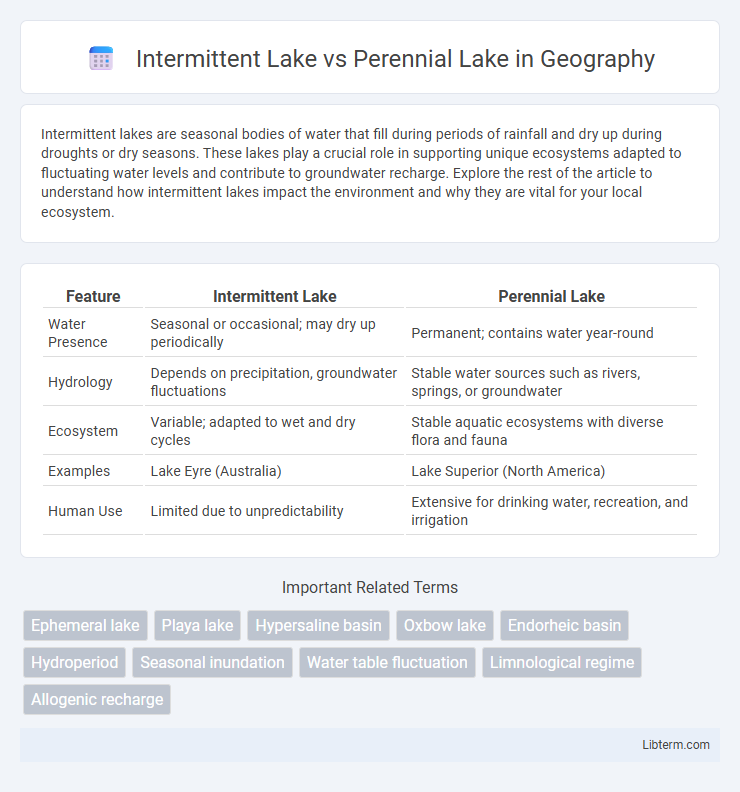Intermittent lakes are seasonal bodies of water that fill during periods of rainfall and dry up during droughts or dry seasons. These lakes play a crucial role in supporting unique ecosystems adapted to fluctuating water levels and contribute to groundwater recharge. Explore the rest of the article to understand how intermittent lakes impact the environment and why they are vital for your local ecosystem.
Table of Comparison
| Feature | Intermittent Lake | Perennial Lake |
|---|---|---|
| Water Presence | Seasonal or occasional; may dry up periodically | Permanent; contains water year-round |
| Hydrology | Depends on precipitation, groundwater fluctuations | Stable water sources such as rivers, springs, or groundwater |
| Ecosystem | Variable; adapted to wet and dry cycles | Stable aquatic ecosystems with diverse flora and fauna |
| Examples | Lake Eyre (Australia) | Lake Superior (North America) |
| Human Use | Limited due to unpredictability | Extensive for drinking water, recreation, and irrigation |
Introduction to Intermittent and Perennial Lakes
Intermittent lakes hold water only during certain seasons or periods, often drying up during dry spells, while perennial lakes maintain water throughout the year. These lakes differ in hydrology and ecosystem dynamics, with intermittent lakes supporting specialized flora and fauna adapted to fluctuating water levels. Perennial lakes provide stable aquatic habitats, ensuring continuous biodiversity and consistent water resource availability.
Definitions: What Are Intermittent Lakes?
Intermittent lakes are water bodies that experience periodic drying, filling only during certain seasons or after significant rainfall, unlike perennial lakes, which retain water year-round. These lakes play critical roles in local ecosystems by providing habitats during wet periods and influencing water cycle dynamics. Their fluctuating water levels contribute to biodiversity and affect regional hydrology, distinguishing them from stable, continuous water bodies.
Defining Perennial Lakes: Key Characteristics
Perennial lakes maintain water throughout the year, supported by consistent inflow from rivers, groundwater, or precipitation, ensuring stable aquatic ecosystems. These lakes often feature diverse flora and fauna due to their continuous availability of water, facilitating sustained biological activity. Unlike intermittent lakes, perennial lakes do not experience significant seasonal drying, making them critical for regional biodiversity and human water use.
Hydrological Differences Between Lake Types
Intermittent lakes experience periodic drying and fill cycles due to variable precipitation and limited groundwater inflow, leading to fluctuating water levels and reduced aquatic habitat stability. Perennial lakes maintain continuous water presence year-round, supported by consistent surface runoff, groundwater inflows, and stable climatic conditions. These hydrological differences influence sedimentation rates, nutrient cycling, and ecosystem diversity within the respective lake basins.
Ecological Significance of Intermittent Lakes
Intermittent lakes play a crucial ecological role by providing unique habitats that support specialized flora and fauna adapted to fluctuating water levels. These lakes contribute to biodiversity by creating breeding grounds for amphibians and migratory birds during wet periods and promote nutrient cycling through periodic drying phases. In contrast to perennial lakes, intermittent lakes offer dynamic ecosystems that enhance regional resilience to climate variability.
Biodiversity in Perennial Lakes
Perennial lakes sustain higher biodiversity due to their continuous water presence, supporting stable aquatic ecosystems with diverse fish, amphibians, and plant species. Intermittent lakes experience fluctuating water levels, which limit habitat stability and reduce species richness. The consistent environment of perennial lakes fosters complex food webs and evolutionary adaptations not commonly found in intermittent lakes.
Human Impact on Intermittent and Perennial Lakes
Human activities such as urban development, agriculture, and water extraction significantly impact both intermittent and perennial lakes by altering their natural water cycles and quality. Intermittent lakes are more vulnerable to changes in precipitation patterns and diversions, leading to longer dry periods and disrupted habitats. Perennial lakes face challenges from pollution runoff, invasive species, and water level fluctuations caused by damming and groundwater depletion.
Climate Influence on Lake Persistence
Intermittent lakes experience periodic drying due to fluctuations in precipitation and evaporation rates, primarily influenced by seasonal or regional climate variability. Perennial lakes maintain continuous water presence year-round, supported by stable precipitation patterns and consistent inflows from rivers or groundwater sources. Climate factors such as temperature changes, drought frequency, and shifting precipitation regimes directly affect the persistence and water balance of both intermittent and perennial lakes.
Water Management Challenges for Both Lake Types
Intermittent lakes face water management challenges related to variable water levels, requiring adaptive strategies to manage sudden inflows and extended dry periods. Perennial lakes demand consistent water quality monitoring and pollution control to sustain aquatic ecosystems year-round. Both lake types require integrated watershed management to balance ecological health with human water use and climate variability.
Conservation Strategies for Intermittent vs Perennial Lakes
Conservation strategies for intermittent lakes prioritize managing fluctuating water levels by maintaining natural hydrological cycles and protecting watershed integrity to support biodiversity during dry periods. In contrast, perennial lake conservation focuses on sustaining consistent water quality and preventing pollution through continuous monitoring and habitat restoration. Both strategies emphasize adaptive management but differ in addressing the temporal variability inherent to intermittent lakes versus the stable conditions of perennial lakes.
Intermittent Lake Infographic

 libterm.com
libterm.com